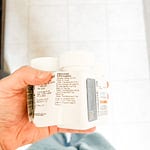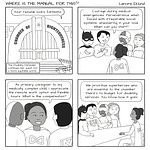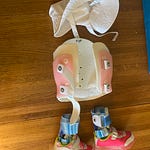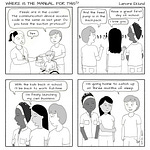“It is well-known that the system of services and supports was not meeting the needs of children with disabilities generally and the situation was even worse for children who are multiply marginalized. The COVID pandemic has exacerbated these problems. But that means that we have opportunities to do better.” — Dr. Amy Houtrow, pediatrician and health researcher
Another of my speaking engagements was published this week, right on the heels of last week’s Oregon Public Broadcasting panel discussion.
I was so honored to be asked to speak at the National Academy of Sciences, Engineering & Medicine’s June workshop: Supporting Children with Disabilities: Lessons from the Pandemic. But it was especially a treat to present alongside folks like North Dakota’s Medicaid Director Caprice Knapp and Dr. Carolyn Foster, who has an amazing body of work on family-centered metrics for the care of disabled children.
Now that the conference videos have been published, I strongly encourage folks to check out the information offered. In the few presentations I’ve been able to watch so far, there is so much good research and passionate speakers for children’s rights and access to quality supports.
My takeaway? We’re not crazy! Pretty much everyone is feeling like the system is seriously broken for kids.
Dr. Amy Houtrow, a pediatrician and health researcher, led the conference. Houtrow summarized a major research project published recently in the journal Pediatrics called A Blueprint for Change: Guiding Principles for a System of Services for Children and Youth With Special Health Care Needs and Their Families. Turns out that 85 percent of families of “children and youth with special health care needs” — a federally defined term — feel that they are not operating in a well-functioning system. And 90 percent of families of disabled children — a subcategory comprising about half of the 14 million American children and youth with special health care needs — think the system isn’t working well. These abysmally low satisfaction rates are a point or two higher if the respondent was white or upper income, but they were lowest for Hispanic families.
The conference was designed to look at what had worked well during the pandemic, and many speakers (like me) advocated for a continuation of emergency flexibilities in health care and social services. Dr. Rishi Agrawal, a physician and professor of pediatrics at Lurie Children’s Hospital in Chicago, enumerated the rights to screening and treatment that children have under federal law. He pointed out that the temporary emergency rate increases, paid parent-caregiving, and telehealth coverage had been shown to be beneficial.
“The question that I want everybody to think about — given the rights that were just enumerated — is should we view them as ‘flexibilities’ or are they expectations in order to be compliant with both the spirit and the letter of the laws, especially Medicaid and EPSDT around what children have a right to?” Dr. Agrawal asked in his presentation. (EPSDT refers to the Medicaid program of Early and Periodic Screening, Diagnostic, and Treatment — comprehensive and preventive health care for young children.) He continued: “Is it truly optional to do the things we did in the pandemic for children?”
My presentation focused on the paid parent-caregiver program. How some states had been doing it even before the pandemic and why I believe the temporary allowances offered during the public health emergency in states like Oregon should continue. I was pretty nervous to give a presentation on such a controversial topic in front of such a venerated audience but I was pleasantly surprised. Many of my co-panelists kept referring to my presentation and agreeing with it.
If you want to watch our discussion, check out the video on this webpage. In the drop-down menu in the top left corner of the video, select video 8 of 19. My segment starts at minute 19:00. The panel’s Q&A discussion, which I also recommend, is video 9 of 19.
Of course, if you have more time, the whole conference is great to watch if you have time and interest in the 19.4 percent of American children who have special health care needs.
As Dr. Houtrow summarized: “It is well-known that the system of services and supports was not meeting the needs of children with disabilities generally and the situation was even worse for children who are multiply marginalized. The COVID pandemic has exacerbated these problems. But that means that we have opportunities to do better.”
Medical Motherhood’s news round up
Snippets of news and opinion from outlets around the world. Click the links for the full story.
• From MarketWatch: “‘We are so burned out, exhausted, overworked and overtired’: Women plead with Congress to act on paid leave and rising child-care costs during emotional hearing on Capitol Hill”
Donna Price of Cleveland had a similar story of making tough choices during the pandemic. She cares for her 18-year-old autistic son and her disabled mother, on top of being a nurse. Her son’s mental health has suffered during the pandemic, and Price said that she had to take eight weeks off without pay to supervise him early last year, when his school and care program went fully remote due to a surge in the virus.
“I struggled to pay rent, put gas in my car, buy groceries, and pay for my mom’s medications,” Price, who is also a member of MomsRising, said. “I was facing $2,000 in unpaid gas bills and $800 in unpaid electric bills. We only made it through with help from my older son and my daughter, who’s a social worker and a police officer. Otherwise, I don’t know what I would’ve done.”
Eventually, Price had to leave her job at a hospital and take a contract nurse position so she could have more flexibility and better care for her son and mother — even though that meant lower pay and fewer benefits.
“I know so many working women can relate to my story,” Price said. “As moms, essential workers, and caregivers for elderly parents, we go out every day and do what we need to do to make sure everyone else is cared for. But sometimes it feels like no one is making sure we’re okay. There are days when I just want to know that my health and my financial and emotional well-being matter. That my elected leaders have my back.”
• From Disability Scoop: “With Roe Overturned, Advocates Fear Disability Rights May Be Next”
Earlier this month, after a draft of the Supreme Court’s decision in the Dobbs case had leaked in May, the Autistic Self Advocacy Network as well as the Disability Rights Education & Defense Fund, AAPD, the Autistic Women & Nonbinary Network, Little Lobbyists and Be A Hero issued a 10-page memorandum outlining a myriad of ways that the ruling could affect disability rights. The document also highlighted the instability that would be introduced into the legal system if the Supreme Court moves away from its long-held practice of following the rules set by previous cases as much as possible.
The memo warned of “devastating consequences” if the draft was not “significantly altered” before it was finalized. But, last week’s ruling largely mirrored the draft.
“Today it was the right to an abortion, tomorrow it could be other important rights like choice of who one can marry or access to other types of reproductive health,” warned Eric Buehlmann, deputy executive director for public policy at the National Disability Rights Network. “For people with disabilities, it might also mean whether or not they have a say in being sterilized, or whom they have intimate relations with or the choice to live in the community guaranteed by the Olmstead decision. This uncertainty that the Supreme Court can take away rights that people have had for decades is bad for all American society, including people with disabilities in so many different ways.”
• From SPARK for Autism: “Lessons from a Study of Severe Autism”
Researchers studying these hospitalized patients have learned several things about autism and psychiatric conditions. Some of their findings include:
• Youth who spoke fluently experienced more depression, and more defiant and argumentative behavior, than those who did not.
• 22 percent of the youth who spoke fluently had talked often about death or suicide.
• About one in four had been the victim of physical, emotional, or sexual abuse, according to their parents. A small percentage of those youth also had post-traumatic stress disorder, also called PTSD.
• Several factors increase the chances that an autistic child or teen will be hospitalized for psychiatric reasons. Having a mood disorder – such as depression or bipolar disorder – is number one. The second most common factor is having a sleep disorder.
“Having sleep problems was a powerful and independent risk factor for psychiatric hospitalization,” explains [Dr. Matthew] Siegel, who is vice president of medical affairs for the Developmental Disorders Services at Maine Behavioral Healthcare.
Medical Motherhood is a weekly newsletter giving those raising disabled children the news and information they need to navigate complex systems. Get it delivered to your inbox each Sunday morning or give a gift subscription. Subscriptions are free, with optional tiers of support. Thank you to our paid subscribers!
Follow Medical Motherhood on Facebook, Twitter, TikTok, Spotify, Apple Podcasts, or Instagram or, visit the Medical Motherhood merchandise store to get a T-shirt or mug proclaiming your status as a “medical mama” or “medical papa.”
Do you have a question about raising disabled kids that no one seems to be able to answer? Ask me and it may become a future issue.













